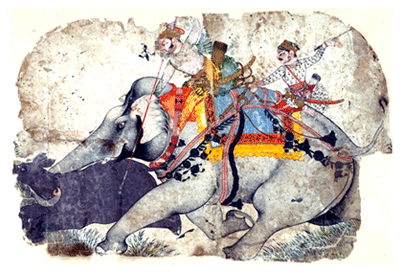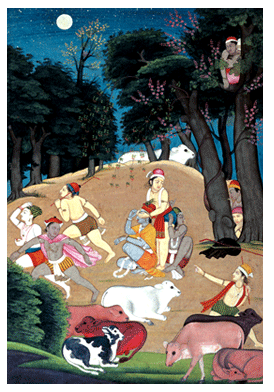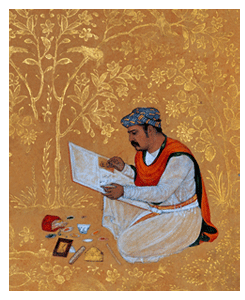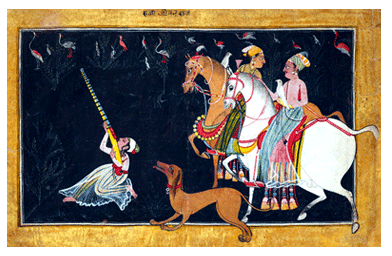- Publisher's Note
- Editorial
- Love of Life (that) Spills Over
- A Continuing Multiplication
- From Painting to Print
- Intimate Involvement
- Portrait of the Artist as an Old Man
- (Hi)Story of the Garhi Printmaking Studios, New Delhi
- Surinder Chadda
- Ramendranath Chakravorty
- Group 8
- Mother and Child: A Screenplay
- Straddling Worlds
- A Brief History of Printmaking at Santiniketan
- Vignettes from History
- Southern Strategies
- The Forgotten Pioneer: Rasiklal Parikh
- Printmaking in the City Of Joy
- Amitabha Banerjee: His Art and Aesthetic Journey
- Local Style and Homogenizing trends: Early Medieval Sculpture in Galaganatha
- English China: Delicate Pallid Beauty
- The Beauty of 'Bilal'
- Photo Essay
- The Way of The Masters: The Great Artists of India 1100 –1900
- Striving Towards Objectivity
- The Art of Sculpting In the Contemporary Times
- An Artistic Framework for an Alternative to Ecology
- Bidriware and Damascene Work in Jagdish and Kamla Mittal Museum of Indian Art
- A Lowdown on the Print Market
- The 'bubble' and the 'wobble'
- What Happened and What's Forthcoming
- Art Bengaluru
- Art Events Kolkata: June – July 2011
- Musings from Chennai
- Mumbai Art Sighting
- Previews
- In the News
- Christie's Jewellery Auction at London, South Kensington
ART news & views
The Way of The Masters: The Great Artists of India 1100 –1900
Volume: 3 Issue No: 19 Month: 8 Year: 2011
Report
1 May to 21 August 2011
Museum Rietberg Zürich, Gablerstrasse 15, CH-8002 Zürich
 The exhibition which was conceived by the Museum Rietberg will also be shown at the Metropolitan Museum of Art in New York from 26 September 2011 to 8 January 2012.
The exhibition which was conceived by the Museum Rietberg will also be shown at the Metropolitan Museum of Art in New York from 26 September 2011 to 8 January 2012.
800 years of Indian painting, some 240 masterpieces by more than 40 artists and all this at a glance. For the first time an exhibition offers a comprehensive overview of the entire history of Indian painting. What makes it even more exciting is that the focus throughout is on individual painters.
In 2011 the Museum Rietberg decided it was high time to celebrate the work of Indian painters from every region of the sub-continent over the last eight centuries. Until now, major exhibitions of Indian painting have usually focused on certain places, periods or themes. This approach shows that more weight tends to be given to the context of the production of Indian paintings such as the patrons who commissioned them,  and the iconographic, religious, and local traditions to which they belong than to the individual painters.
and the iconographic, religious, and local traditions to which they belong than to the individual painters.
This exhibition is the result of decades of painstaking research. To identify individual artists, microscopically small signatures were deciphered, pilgrim registers were searched for artists' names and genealogies, and systematic stylistic comparisons were made.
Scarcity of source material has made this a particularly challenging undertaking Indian art history lacks any equivalent of Vasari's biographies of European renaissance artists. The memoirs of the emperors Akbar (reg. 1556–1605) and Jahangir (reg. 1605–1627), in which artists were described and their qualities discussed, are a great exception.
These paths are the focus of the exhibition. Changing patrons, and other external events, shaped the stylistic development of each artist's work, and this can be seen here. The career of every artist is documented with between three and ten representative works. Importantly, too, the way the exhibition has been planned highlights comparisons between artists from the same family over generations, or between artists who were working at the same time.
If, for example, one looks at the careers of the two brothers Manaku and Nainsukh who were both trained in their father's workshop in Guler,  interesting differences emerge. Whereas Manaku stayed closer to the traditional painting style of his father, Nainsukh settled at another court and developed his own unique pictorial language there, one which excels especially in the use of newer naturalistic elements.
interesting differences emerge. Whereas Manaku stayed closer to the traditional painting style of his father, Nainsukh settled at another court and developed his own unique pictorial language there, one which excels especially in the use of newer naturalistic elements.
Searching for innovative forms of expression, the painters kept developing their skills throughout their careers, in a critical engagement with their artistic training and with foreign influences. The creative paths followed by individual masters are fascinating and is some cases the geographical paths followed are also impressive.
Farrukh Beg, for example, was trained in Khorasan in central Asia and subsequently worked in Kabul, Lahore, Bijapur and Agra. The famous emigrant thus covered distances of several thousand kilometres. One of the reasons for this was his search for a patron who would support his artistic visions.
But a quest for self-realisation like Farrukh Beg's was an exception in large workshops; at the court of Emperor Akbar, for example, the stylistic coherence of an illustrated manuscript was rated higher than the qualities of the individual artists.  The work by Bagta and his son Chokha shows this clearly and reveals enormous stylistic changes. After being trained in a large workshop, they went to a small court and their style changed almost overnight as if creative energy had suddenly been given free rein – it seems that at smaller courts artistic freedom was less restricted by superimposed rules.
The work by Bagta and his son Chokha shows this clearly and reveals enormous stylistic changes. After being trained in a large workshop, they went to a small court and their style changed almost overnight as if creative energy had suddenly been given free rein – it seems that at smaller courts artistic freedom was less restricted by superimposed rules.
More than forty artists stand at the centre of the exhibition, and their works convey a broad and comprehensive idea of Indian painting to the visitors. The earliest exhibits are illustrated manuscripts from the twelfth century; the latest works from the early twentieth century are large-format paintings from Udaipur which in their choice of composition and perspective reveal the growing influence of photography.

The exhibition is testimony to a lively exchange between artists; pictorial ideas and compositions were swopped, refined, and further developed right across the sub-continent from the courts of the Himalayan foothills to the workshops in the southern Deccan region.
Probably the biggest impulse came from painters who had been trained in Persia and were invited to India by the Mughal emperors. Different aesthetic concepts (such as that represented in the painting of the Safavid dynasty, 1501–1722) were pursued and enlivened in an environment which was very fruitful for the arts. European pictures, especially allegorical or Christian engravings, were also circulating among the artists and met with varied responses. Western techniques for representing perspective, in particular, fascinated and inspired numerous artists.
The structure of the exhibition gives each artist the space he deserves and at the same time follows the different branches of development in Indian painting. Thus visitors can follow individual artists through a line of tradition and at the same time can acquire an overview of the history of painting in the sub-continent.
 Through its love for pictorial art, India has come to possess an incomparable treasury of artworks radiating with visual and material splendour. With their incredible dedication to detail and to the intricate execution of even the most seemingly minor motifs, they transport the viewer into another world.
Through its love for pictorial art, India has come to possess an incomparable treasury of artworks radiating with visual and material splendour. With their incredible dedication to detail and to the intricate execution of even the most seemingly minor motifs, they transport the viewer into another world.
As exotic as names such as 'Abd al-Samad, Kripal and Sahibdin may sound, these artists all share a great technical refinement, compositional inventiveness and sense of colour. It is not surprising that Rembrandt possessed a collection of Indian miniatures.
Images Courtesy: Museum Rietberg